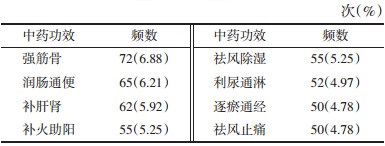文章信息
- 王永康, 李莉, 王艳国
- WANG Yongkang, LI Li, WANG Yanguo
- 基于《中华医典》文献挖掘的膝痹用药规律研究
- Study on the medication law of knee arthralgia syndrome based on the literature mining in the Traditional Chinese Medicine Book
- 天津中医药, 2022, 39(6): 724-728
- Tianjin Journal of Traditional Chinese Medicine, 2022, 39(6): 724-728
- http://dx.doi.org/10.11656/j.issn.1672-1519.2022.06.11
-
文章历史
- 收稿日期: 2022-01-23
2. 天津市和平区中医医院内科,天津 300050
膝痹属中医痹证范畴,临床主要表现为膝部疼痛,或伴酸软、沉重、肿胀、屈伸不利、骨鸣等[1]。西医称之为膝骨关节炎(KOA)、原发性增生性膝关节炎、退行性膝关节炎,多见于中老年人,女性多于男性,60岁以上患病率达50%,75岁高达80%,致残率53%[2]。西医治疗主要是依靠非甾体抗炎药或关节腔注射透明酸钠等,严重者予手术治疗,不仅费用高,而且还存在不良反应,因此中医药治疗膝痹具有重要意义。本研究以《中华医典》为检索数据库,对其中关于治疗膝痹的处方进行整理,研究其用药规律,以期为临床提供思路和方法。
1 方法 1.1 数据来源以“膝痹”“膝痛”“膝肿”等作为关键词,通过对第5版《中华医典》[3]中“方书类-综合方书”部分的中医典籍进行检索,由两名人员独立提取文献中涉及的中药方剂。
1.2 纳入标准1)参照《中医病证诊断疗效标准》中有关“膝痹”的诊断。2)内服方剂,剂型不限。3)方剂组成相同,药物剂量不同的亦纳入。4)引用前人或互相引用的方剂只纳入最早1条。5)同方不同名的方剂仅纳入1次。
1.3 排除标准1)不符合纳入标准的方剂。2)有证候或方名,但无具体药物组成的方剂。3)外用的中药方剂。4)重复的方剂。5)以“膝痹”“膝痛”“膝肿”等关键词作为修饰性词语,实际与膝痹无关之条文。
1.4 中药名称规范化以《中药学》[4]为标准,将文献中的中药药名进行规范统一,如桂心统一为肉桂,天雄统一为乌头等。
1.5 数据挖掘方法将上述数据导入中国中医科学院中医药信息研究所研发的“古今医案云平台”软件,对数据进行用药频次、中药属性、关联关系及聚类分析[5-7]。
2 结果 2.1 文献检索结果按上述纳入、排除标准筛选后,共纳入107首中药方剂,涉及214味中药。
2.2 中药频次分析结果对107首治疗膝痹的中药方剂数据进行频数统计,频次排序前5位的中药分别是牛膝、当归、甘草、羌活、川芎,排名前15位中药见表 1。
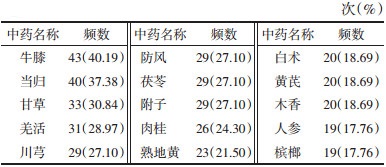
|
对107首治疗膝痹的中药方剂数据进行中药四气统计,其中温性药物使用频数最高,高达343次,其次为平性药物、微温性药物。见图 1。
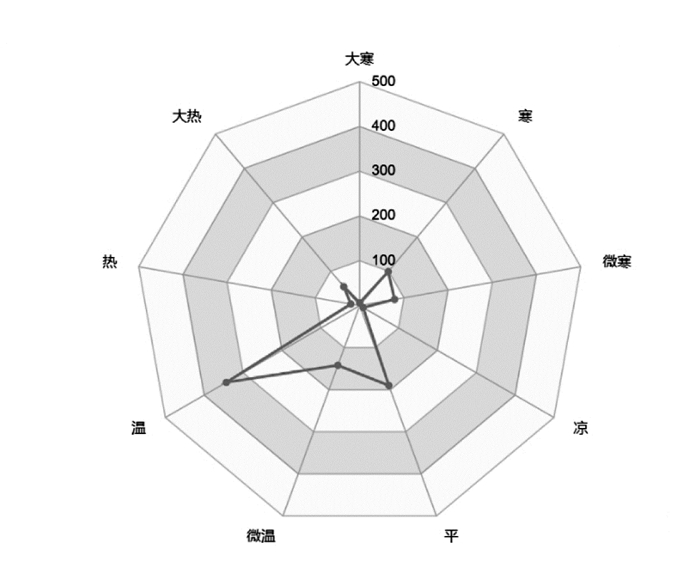
|
| 图 1 中药四气使用频次雷达图 Fig. 1 Radar chart of using frequency of four-qi in traditional Chinese medicine |
对107首治疗膝痹的中药方剂数据进行中药五味统计,其中辛味药物使用频数最高,其次为甘味药物、苦味药物、酸味药物。见图 2。
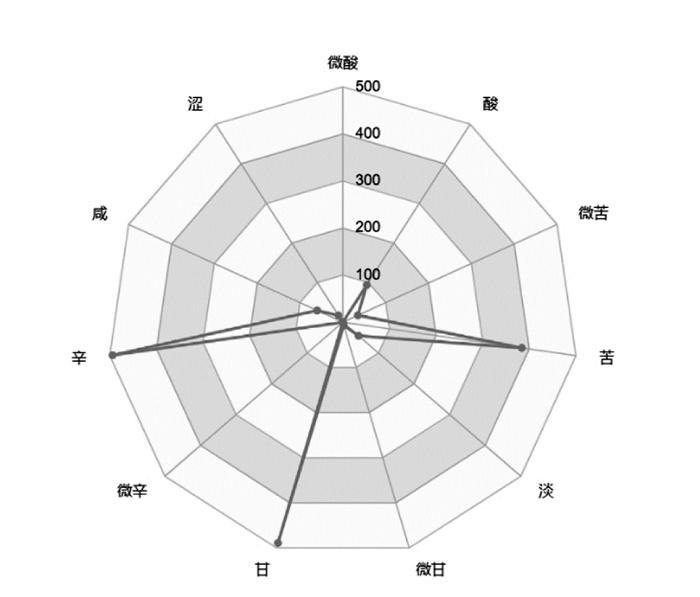
|
| 图 2 中药五味使用频次雷达图 Fig. 2 Radar chart of the frequency of use of five flavor |
对107首治疗膝痹的中药方剂数据进行中药归经统计,使用频数较高的药物归经是脾经,其他依次是肝、肾、胃、心经。见图 3。
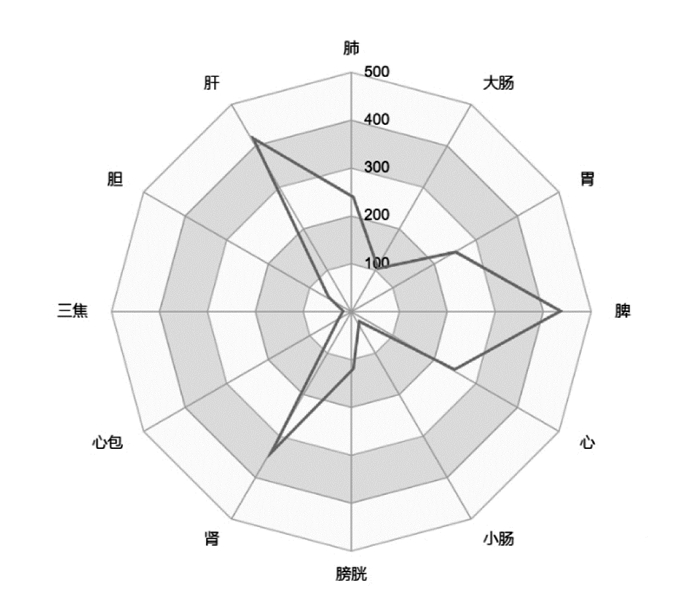
|
| 图 3 中药归经使用频次雷达图 Fig. 3 Radar chart of frequency of use of traditional Chinese medicine in meridian tropism |
对107首治疗膝痹的中药方剂数据进行中药功效频数排名前8位的药物统计,其中强筋骨药最多。见表 2。
对107首治疗膝痹的中药方剂数据进行关联规则分析,设置同现频数≥15次、置信度≥0.6、支持度≥0.1,最终得到关联规则数据18条。举例说明,当出现防风时,出现牛膝的频率为75%,且共同出现了21次,公式表示为Confidence=P(A∪B)/ P(A)。支持度0.20表示“同时涵盖防风和牛膝的处方”占“本研究所有处方”的比例为20%,公式表达为Support=P(A∪B)。提升度1.87则是“包含防风的处方中同时包含牛膝的比例”与“包含牛膝处方的比例”为1.87,公式表达为Lift(A→B)= P(B|A)/ P(B)。提升度代表中药之间的相关性,提升度>1时,提升度越高表明中药间正相关性越高[8]。本研究提升度都大于1,表明中药间呈正相关性,见表 3。
在107首治疗膝痹的方剂中,对使用频数排名前20位的中药进行聚类分析,分4类,第1类:茯苓、肉桂、乌头、苍术,第2类:陈皮、枳壳、木香、槟榔,第3类:牛膝、附子、羌活、防风,第4类:当归、甘草、川芎、熟地黄、杜仲、白术、黄芪、人参。见图 4。
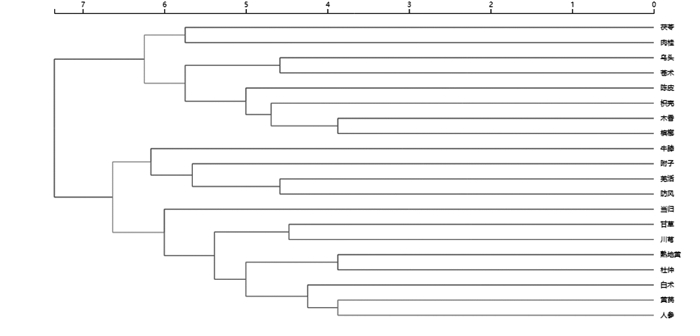
|
| 图 4 中药聚类分析图 Fig. 4 Cluster analysis diagram of traditional Chinese medicine |
痹证最早见于《素问·痹论》中提出的“风寒湿三气杂至,合而为痹也”,明确阐述了其病因病机。在明清时期其治疗理念趋于成熟,不仅确立了从“肝肾论治”,还提出了“痹有瘀血”“久病入络”等观点。膝痹以本虚标实,肝肾亏虚为本,筋脉瘀阻、感受风寒湿邪为标,中医治疗应补肝肾强筋骨、疏经活络。
本研究频数统计结果显示,高频用药包括牛膝、当归、甘草、羌活、川芎、防风、茯苓、附子等,排在首位的牛膝具有补肝肾、强筋骨、引血下行等作用,邹来勇等[9]研究发现牛膝多糖可降低KOA兔骨桥蛋白水平,骨桥蛋白水平越低KOA越轻,由此可知牛膝多糖对兔子KOA有一定的治疗效果。排在第2位的当归具有活血止痛、补血通经等作用。有研究发现当归提取物阿魏酸钠可通过促进基质金属蛋白酶抑制剂-1(TIMP-1)表达、抑制基质金属蛋白酶1(MMP-1)表达以控制动物的KOA进展,还能降低人类软骨细胞中加速软骨退变的一氧化氮浓度[10]。排在第3位的甘草具有补脾益气、缓急止痛、清热解毒、调和诸药的作用。李永忠等[11]研究发现甘草总皂苷能抑制白介素-6、肿瘤坏死因子-α、一氧化氮的分泌,从而抑制造模动物KOA的发展。
通过分析药物属性可知,四气以温为主,温通经脉;五味以辛为主,辛味药能散、能行,主要用于治疗表证和气血瘀滞证,寒湿是导致膝痹的首要因素,湿性黏滞重浊,寒性凝滞收引,容易阻滞气机,故用辛味药以散寒、通络;归经以脾经、肝经、肾经多见,与中医“脾主肉、肝主筋、肾主骨”的理论相吻合,诸多医家也提出从肝脾肾论治,黄辉文等[12]采用益气健脾、滋补肝肾法治疗KOA,患者膝关节疼痛明显减低,功能恢复较好。
通过关联规则分析,提示临床用药应注重牛膝、防风、川芎、当归等药物的使用,防风-牛膝、川芎-甘草、甘草-当归、川芎-当归、防风-羌活为关联强度较强的前5对组合,药物组合以补肝肾、强筋骨、祛风除湿、活血通络为主。牛膝补肝肾、强筋骨,还能活血化瘀、祛风除湿,配伍防风加强祛风湿之效;当归乃血家圣药,治疗风寒湿痹痛时常配伍防风、羌活、川芎等,即蠲痹汤主要成分,以活血散寒止痛[13]。
通过聚类分析,第1类药物茯苓、肉桂、乌头、苍术都可祛湿邪,茯苓、苍术健脾,肉桂、乌头温经散寒止痛,肉桂又可引火归源、活血通经。第2类药物陈皮、枳壳、木香、槟榔均可理气,痹证久病入络,气血阻滞,故用理气药以使气血通畅,痹痛自止[14]。第3类药物羌活、防风合川芎、甘草等为羌活胜湿汤,有祛风除湿、通经活络的作用;牛膝、附子则为《圣济总录》中记载的牛膝附子酒,其用于痹证,主治腰膝酸痛、行走屈伸不利等[15]。第4类药物当归、甘草、川芎、熟地黄、杜仲、白术、黄芪、人参为补益肝肾和益气之品,膝痹以“正气亏虚、肝肾不足”为本,本虚则外邪侵袭,痹阻经络,故固护正气为治病之本。
4 结论本研究通过对《中华医典》中107首治疗膝痹方药的研究,发现膝痹用药多为辛味、温性、归脾肝肾经,提供了从肝脾肾论治膝痹的思路。功效多以强筋骨、补肝肾药为主,亦可见祛风除湿、逐瘀通经类等药物,故临床应辨证施治,在强筋骨、补肝肾的同时要兼顾祛风除湿、逐瘀通经等应用,标本同治,虚实兼顾。本研究与现代诊疗规范中用药基本一致,可见挖掘古代医籍进行数据分析对临床诊疗的重要性。
| [1] |
娄玉钤. 中医风湿病学[M]. 北京: 人民卫生出版社, 2010: 227-232. LOU Y Q. Rheumatology traditional Chinese medicine[M]. Beijing: People's Medical Publishing House, 2010: 227-232. |
| [2] |
邱贵兴. 骨关节炎诊治指南(2007年版)[J]. 中华关节外科杂志(电子版), 2007, 1(4): 281-285. QIU G X. Guidelines for the diagnosis and treatment of osteoarthritis(2007 edition)[J]. Chinese Journal of Joint Surgery (Electronic Version), 2007, 1(4): 281-285. |
| [3] |
裘沛然. 中华医典[M/CD]. 长沙: 湖南电子音像出版社, 2014. QIU P R. Chinese Medical Code[M/CD]. Changsha: Hunan Electronic Audio and Video Publishing House, 2014. |
| [4] |
钟赣生. 中药学[M]. 4版. 北京: 中国中医药出版社, 2016: 1-10. ZHONG G S. Traditional Chinese medicine[M]. 4th Edition. Beijing: China Press of Traditional Chinese Medicine, 2016: 1-10. |
| [5] |
陶源, 赵迎盼, 张琦圣, 等. 基于古今医案云平台的《医方考》脾胃病方证用药规律分析[J]. 中国中西医结合消化杂志, 2020, 28(2): 124-127. TAO Y, ZHAO Y P, ZHANG Q S, et al. Study on the regularity of pharmacy in Yi Fang Kao in treatment of Spleen and Stomach diseases based on the ancient and modern consilia cloud platform[J]. Chinese Journal of Integrated Traditional and Western Medicine on Digestion, 2020, 28(2): 124-127. |
| [6] |
李娟, 杨柱, 龙奉玺, 等. 刘尚义治疗肝胃不和证用药规律数据挖掘分析[J]. 辽宁中医杂志, 2018, 45(9): 1845-1848. LI J, YANG Z, LONG F X, et al. Analysis of LIU Shangyi's clinical experience in treating liver stomach disharmony syndrome based on data mining[J]. Liaoning Journal of Traditional Chinese Medicine, 2018, 45(9): 1845-1848. |
| [7] |
夏清. 基于数据挖掘的徐春军教授诊治肝硬化腹水的临床经验研究[D]. 北京: 北京中医药大学, 2018. XIA Q. Clinical experience of Professor XU Chunjun in diagnosis and treatment of ascites due to cirrhosis based on data mining[D]. Beijing: Beijing University of Chinese Medicine, 2018. |
| [8] |
张文顺, 曲超, 佟奕霖, 等. 基于古今医案云平台的中医药治疗早期糖尿病肾病组方规律研究[J]. 中华中医药学刊, 2021, 39(2): 243-247, 288. ZHANG W S, QU C, TONG Y L, et al. Study on medication regularity of traditional Chinese medicine in treatment of diabetic nephropathy based on ancient and modern medical records cloud platform[J]. Chinese Archives of Traditional Chinese Medicine, 2021, 39(2): 243-247, 288. |
| [9] |
邹来勇, 方芳, 汤群珍. 牛膝多糖对兔膝骨关节炎骨桥蛋白表达的影响[J]. 光明中医, 2014, 29(8): 1625-1627. ZOU L Y, FANG F, TANG Q Z. Effect of Achyranthes Bidentata polysaccharide on osteopontin expression in rabbit knee osteoarthritis[J]. Guangming Journal of Chinese Medicine, 2014, 29(8): 1625-1627. DOI:10.3969/j.issn.1003-8914.2014.08.021 |
| [10] |
SHANG L, QIN J, CHEN L B, et al. Effects of sodium ferulate on human osteoarthritic chondrocytes and osteoarthritis in rats[J]. Clinical and Experimental Pharmacology & Physiology, 2009, 36(9): 912-918. |
| [11] |
李永忠, 闵华, 刘超, 等. 骨关节炎疾病中白细胞介素17协同肿瘤坏死因子α调节诱导型一氧化氮合酶的表达[J]. 中国组织工程研究, 2012, 16(24): 4393-4397. LI Y Z, MIN H, LIU C, et al. Interleukin-17 and tumor necrosis factor alpha regulate the expression of inducible nitric oxide synthase in rheumatoid arthritis[J]. Chinese Journal of Tissue Engineering Research, 2012, 16(24): 4393-4397. DOI:10.3969/j.issn.1673-8225.2012.24.005 |
| [12] |
黄辉文, 戚子荣, 丘青中. 膝三脏汤合并中药外洗对膝骨关节炎患者Lysholm膝关节评分及VAS评分的影响[J]. 现代中西医结合杂志, 2018, 27(13): 1399-1401, 1406. HUANG H W, QI Z R, QIU Q Z. Effect of the combination of knee-three-organs decoction and traditional Chinese medicine washing on lysholm knee score and visual analog scale in patients with knee osteoarthritis[J]. Modern Journal of Integrated Traditional Chinese and Western Medicine, 2018, 27(13): 1399-1401, 1406. |
| [13] |
孙奇, 郎永, 胡柏松, 等. 基于数据挖掘技术的张玉柱治疗早期膝骨性关节炎(膝痹病)的用药规律研究[J]. 中国中医骨伤科杂志, 2019, 27(11): 51-54. SUN Q, LANG Y, HU B S, et al. Study on the rule of ZHANG Yuzhu's medication in the treatment of early knee osteoarthritis (knee arthralgia) based on data mining technology[J]. Chinese Journal of Traditional Medical Traumatology & Orthopedics, 2019, 27(11): 51-54. |
| [14] |
杨振武, 李木清, 姜雄. 中医药治疗膝痹的用药规律研究[J]. 湖南中医杂志, 2019, 35(10): 139-140, 152. YANG Z W, LI M Q, JIANG X. Study on the Law of traditional Chinese medicine in treating knee arthralgia[J]. Hunan Journal of Traditional Chinese Medicine, 2019, 35(10): 139-140, 152. |
| [15] |
张丰聪, 王金玲, 王振国. 酒剂在《圣济总录》中的应用[J]. 中华中医药杂志, 2012, 27(6): 1496-1498. ZHANG F C, WANG J L, WANG Z G. Application of medicinal wine in General Medical Collection of Royal Benevolence[J]. China Journal of Traditional Chinese Medicine and Pharmacy, 2012, 27(6): 1496-1498. |
2. Internal Medicine, Tianjin Heping District Hospital of Traditional Chinese medicine, Tianjin 300050, China
 2022, Vol. 39
2022, Vol. 39





